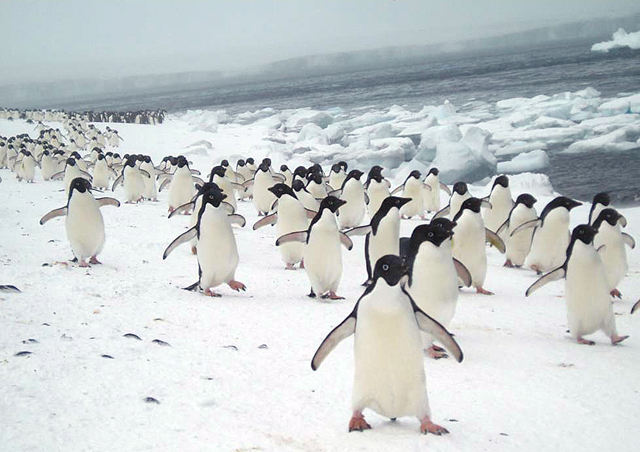Changing dietKrill surplus 200 years ago may have caused penguins to shift prey preferencesPosted October 30, 2009
Most of us have heard the oft-repeated phrase, “You are what you eat.” Turns out it’s not just a way for your mother to nag you about your poor eating habits. By studying the tissue remains of penguins in Antarctica, scientists are not only learning more about the modern diet of the continent’s iconic seabird but also what was on the menu thousands of years ago. And that information can provide insight into past climate and penguin behavior, as well as how the species could respond to future climate changes. Steve Emslie Related Story
Much of their work involves collecting tissue samples, such as eggshells and feathers, from existing penguin colonies and long-extinct ones around the Antarctic Peninsula and the Ross Sea regions. Then they analyze the samples in the lab, looking at the ratios of carbon and nitrogen stable isotopes, which can provide important clues to what’s been on the dinner plate throughout the year. “It’s mainly based on the fact that you are what you eat,” explained Emslie, who will return to McMurdo Station For example, shifts in carbon isotope ratios can indicate if a bird feeds inshore or in the marine environment. Nitrogen isotope ratios indicate how far up or down an animal feasts on the food chain. “We look at that as a way to assess diet and how it has shifted through time as well with the Pygoscelis penguins, and also through space by the different colonies in the different regions of the Antarctic,” Emslie said. In a study published two years ago in the journal Proceedings of the National Academy of Sciences, Emslie and collaborator William Patterson suggested that the krill-centric diet of today’s Adélie penguin is a recent phenomenon, a shift that occurred maybe 200 years ago. Their suggestion is based on a change in the nitrogen stable isotope ratio in penguin tissue. 
Photo Credit: Michael Polito
Adélie penguins march along Brown Bluff at the northern end of the Antarctic Peninsula.
Two hundred years ago is about the time when whalers began decimating the waters around Antarctica of krill-eating whales and seals, creating what Antarctic scientists in the 1960s and 1970s labeled as a “krill surplus,” Emslie said. “It makes sense,” he said. “Krill per gram are just as rich in protein as fish but during a krill swarm, you can gather a lot more food a lot more quickly than you could in a school of fish. We think that’s probably why they did that switch — when krill became more abundant — even though fish were probably still available.” Now the scientists are testing the idea further by looking at gentoos, another Pygoscelis penguin, a mostly subantarctic bird that is pushing its way across the northern end of the Antarctic Peninsula as the climate there warms and the Adélie population declines. “We’re not sure it will show up because gentoos are known to eat a lot more fish and squid in their diet anyway compared to Adélies,” Emslie said. The scientists know the shift in diet for the Adélies in the Ross Sea region is relatively recent because tissue samples dating back at least 40,000 years from extinct colonies in the region suggest a diet richer in fish. “Surprisingly, there weren’t any noticeable shifts [in diet] between warm and cold [periods] that are known from ice core records,” Emslie said. “That was kind of a surprise as to why there would be a sudden shift in diet historically that wasn’t related with these climate intervals,” he said, referring to the krill surplus that resulted from whaling. Emslie said it’s difficult to pin down an exact date on when Adélies began to prefer krill, but it was certainly happening by the beginning of the 20th century based on an analysis of Adélie eggs stored in explorer Robert F. Scott’s Hut on Cape Evans that were collected from a nearby colony sometime between 1911-1917. “They became a nice historical sample to run isotope analysis on to see if the dietary switch had occurred by the early 1900s, and the data suggest that it had,” Emslie said. “On the peninsula you would expect it to occur first because it was hit hard first by the sealers and whalers.” 1 2 Next |



For USAP Participants |
For The Public |
For Researchers and EducatorsContact UsU.S. National Science FoundationOffice of Polar Programs Geosciences Directorate 2415 Eisenhower Avenue, Suite W7100 Alexandria, VA 22314 Sign up for the NSF Office of Polar Programs newsletter and events. Feedback Form |


